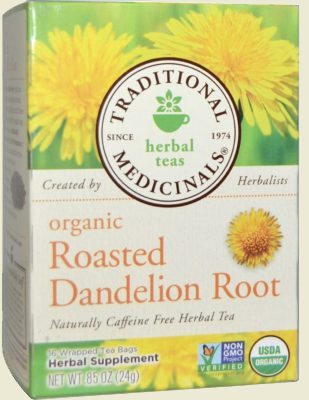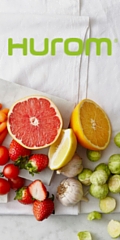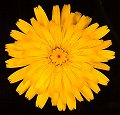Dandelion to DYE for!
Dandelion root makes magenta when using alum as the mordant. Alum is a salt that in its most common form, potassium aluminum sulfate—or potash alum, is used as an additive in small amounts to make pickles and maraschino cherries, and in another common form, sodium aluminum sulfate, is an ingredient in commercially produced baking powder. If you use a tin (a “tin can” is a top commercial choice for storing food) and vinegar mordant you can get purple. Add no mordant to get a yellow dye, the color from using the flowers alone.
Would you like to make your own dandelion-dyed napkins and a matching tablecloth to enhance your enjoyment of every cup of dandelion tea you drink? Well, let’s get started! First, go get some dandelions.
How to dye using dandelions
Using an enamel or stainless steel pot that you will not be using for cooking, soak dandelion roots—or whole plants—overnight in water. Bring to a boil in the same water and then dip them out with a wooden spoon.
Wash the material you wish to dye in warm soapy water and keep it wet. The dye bath is your key to color. If you wish your pigment to be colorfast, put a mordant in the pot with one cup of water: about a half teaspoon of alum mordant for every two ounces of material, taking care not to breathe in the mordant fumes.
Heat—do not boil—gently and stir until dissolved, add 2 quarts water, and stir well to mix. Your saturated textile goes into this bath; bring up to a slow simmer. Turn down the heat as the water begins to boil; simmer 1 hour. Stir occasionally.
Note: When dyeing, ensure the fabric stays completely covered with water, and remember, materials appear darker wet than dry.
Turn off the heat, let cool, squeeze out excess water, and then rinse in warm water to remove the alum. Different dye materials will dye at different speeds. After the dyebath starts to simmer, check in 15 minutes if you wish to have a pale color. Leave the material in the dyebath longer for a deeper or richer color. For full color saturation, leave overnight in the dyebath. This dyeing process can make for a fun dandelion teatime; enjoy experimenting!




July 7th, 2010 at 11:55 am
Glad I found this site, was contemplating using the flowers to dye something with and my need is to store the dye until a time that I want to use it. I wanted to make and store for the winter months when activities at the ranch where I live are limited. If anyone could tell me how to do this I would really like to have that knowledge. We have lots of dandelion’s right now and would like to make use of them later. If you have any knowledge that would make that possible please let me know and you can publish the comment and the question just not the e-mail. Thanks Tina
April 4th, 2011 at 9:58 am
I would try dehydrating them and grinding the flowers to a powder to store in a jar. I have absolutely no knowledge on using plants to dye material but I think I might start trying it. Good luck. 🙂
April 7th, 2011 at 12:00 pm
Try freezing them. I have had success storing other plants and flowers in a sealed bag in the freezer & am currently trying it with dandelions. It usually works, although you can’t be very accurate with measurements.
Good Luck! x
May 15th, 2012 at 8:50 am
[…] is. The root can be roasted, ground and brewed like coffee. The root can also be used to dye wool. The leaves can be eaten in salads or cooked like spinach (I admit the greens are not my favorite […]
May 13th, 2015 at 12:37 pm
Does anyone have any idea how this can be applied as a purple hair dye?…Preferably with the roots and salt/vinegar (no alum).
April 12th, 2016 at 11:41 am
[…] I could’ve used dandelion root tea! Or maybe I could taste-test some of the dye bath! Or maybe not. I’ll keep this option in mind for the winter and maybe try other herbal teas. […]
May 21st, 2020 at 3:49 am
I really loved your post. I read your blog quite often and I just shared it on Facebook.
Keep up the good work.
May 24th, 2020 at 11:02 am
Thanks!
October 12th, 2020 at 5:34 pm
Just love how old wives tales get perpetuated over and over, thanks for the laugh. Dandilion root has never, will never give purple or magenta or anything but beige, even with a mordant. The flowers and leaves however will give pleasant yellows, but unfortunately not long lasting.
October 27th, 2020 at 12:42 pm
Arlee, wow, I really enjoyed hearing from you! Thank you! I like to do my own research but in this case had no mordant, not many dandelions (the deer and rabbits around here like them a lot), and didn’t try making dandelion dye myself. You are absolutely correct about misinformation getting passed on and around, and I apologize if I am contributing! I had so hoped to get vibrant magenta, a favorite color of mine, “some day” from dyeing with dandelion! You have inspired me to go get the mordant and try dying the entire plant – when it starts blooming again – to see if I can get color from dandelion besides the colors it grows: green leaf, yellow blossom, beige root. And I plan to follow up with my results! Ruth
March 29th, 2023 at 10:35 am
I tried these instructions twice, once with the roots and once with the whole plant. Both produced something between yellow and tan that just makes your fabric look old and dirty. Maybe if you just use the reddish stems…?